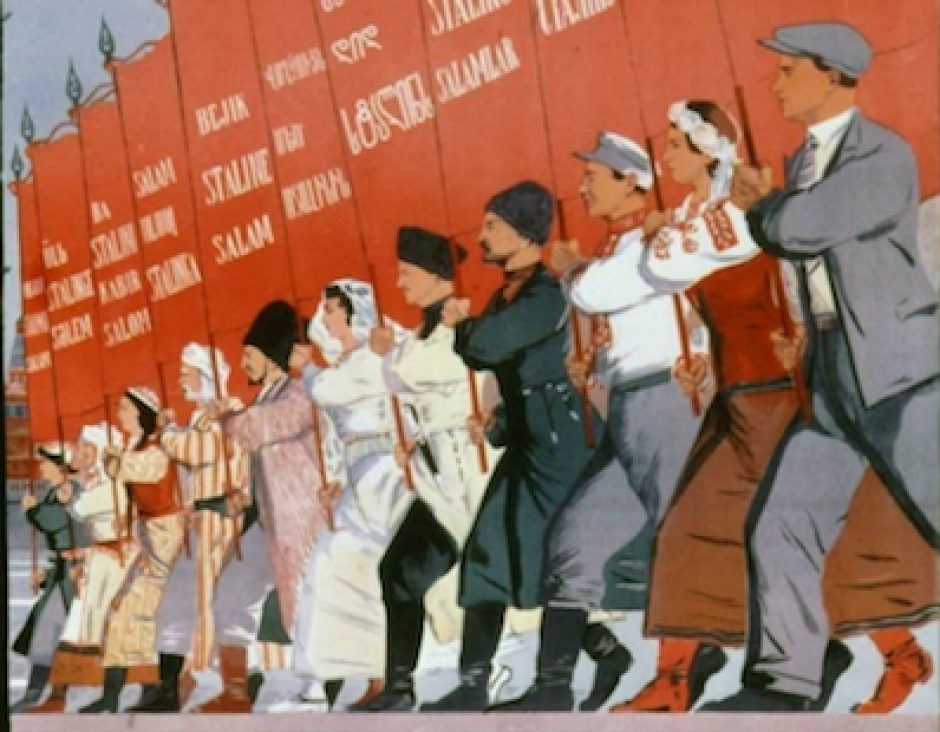What struck me the most about Chapters 14-18 was how much the lives of (former) Kazakh nomads had changed. I read with this meta-question in mind: how does Mukhamet mourn – or not – the passing of the nomadic way of life? And how does he understand his new, Sovietised way of life? It’s impossible underestimate what has changed. Geographically, the steppes have given way to industrial complexes and collective farms; all connected at a grand scale through Soviet steamer and train, yes, but paradoxically leaving Mukhamet and his relations more disconnected than ever:
“[…]the traditional socializing between neighboring aul had almost ceased due to lack of transport. (172)
More intriguingly, Kazakh nomadic folkways and customs have given way to new structures and hierarchies that Soviet administration has imposed on life – the demands of settled argriculture vs. pastoral nomadism, old clan elites versus Soviet administrative elites, and, most perversely of all, a famine that eventually catches up with Mukhamet and his family.
It’s an entirely new world for him. But Mukhamet isn’t constantly pointing out these differences between the nomadic way of life, and the new Sovietised way of life. To answer the meta-question and understand what Mukhamet makes of his new way of life, then, we ask a more specific question: how does Mukhamet comment all of these changes, and what do they reveal about him? I can’t fully answer this question, but I’ll sketch out precisely how Mukhamet’s writing resists a question like this.
For one, we aren’t given an official Soviet view on what settling Kazakh nomads on collective farms was meant to accomplish – in fact, it’s telling that Mukhamet isn’t glossing his memories with an official Soviet view. Why does Mukhamet choose not to give the Soviet perspective on events like collectivization and the famine? We aren’t given anything comparable to the rhetoric of “backwardness” and “uplift” that accompanied the Turksib, for example.
Here’s another way in which Mukhamet resists giving us a straight answer: despite all the evident misfortune that Mukhamet suffers, he offers limited criticism of Soviet power. What can Mukahmet’s criticisms of Soviet power, to the extent that he does criticise Soviet power, tell us about what he rejects – and what he accepts – of Soviet power? Soviet power may have reduced his family to a precarious life of informal employment – ironically enough, a nomadic life; it has also permanently separated him from his father, and destroyed the usual familial ties that would have helped Mukhamet and his family in times of crisis. (Chapter 17 focuses in particular on how some of his relatives, having gotten well-compensated Soviet jobs, have suddenly lost interest in their relations.) But Mukhamet’s criticisms ultimately target faceless central Soviet power for its responsibility for the famine:
“Tragically, however, our leaders ere more concerned about Party delegates than they were about the deaths of working people.” (189)
He does not fault the Kazakh leadership – “it was not their fault that they did not have the [resources…] everything was in the hands of the Soviet government.” (188) Nor does he fault the lower rungs of authority: eating with an acquaintance, the vice-chairman of an aul council, he observes how materially well-off the chairman’s family is compared to those stricken by famine around him. But he begs the question by simply commenting that “the food had surely been sent by God.” (189)
To sum up, Leah observed last class that Mukhamet seemed to be pulling his punches. Although it’s telling that Mukhamet is choosing at all to tell us about the precarious life that Soviet power forced him into, it’s also telling that, to understand Mukhamet’s attitudes, we’ve had to do a little indirect reading to understand what he makes of Soviet power.
Here’s a final thought: perhaps the life he’s leading right now is a temporary one, a Stalinist parenthesis – that would explain why Mukhamet isn’t stopping and taking stock of what’s changed. Or maybe he’s taking this new Sovietised life as a new normal: he speaks, in a sentimentalising tone, about “simple, honest, rank-and-file collective farmers” (169) in contrast with well-off Soviet officials. Given how new collectivisation was, though, would these identities – “kulak”, “collective farmer”, “aul chairman” – have made sense to Kazakhs of the period? I think not: I think they would’ve seen themselves as nomads lost in an alien world.
